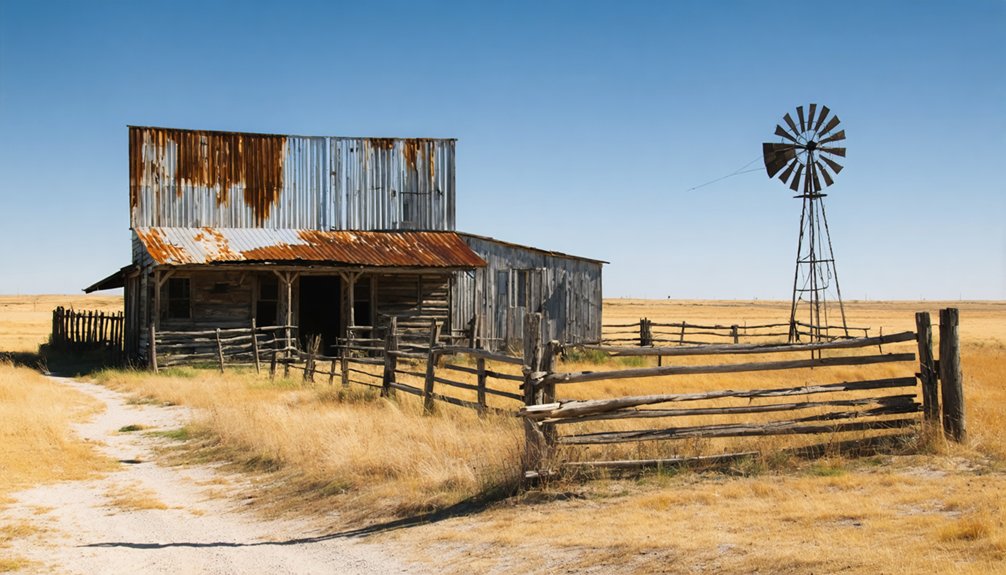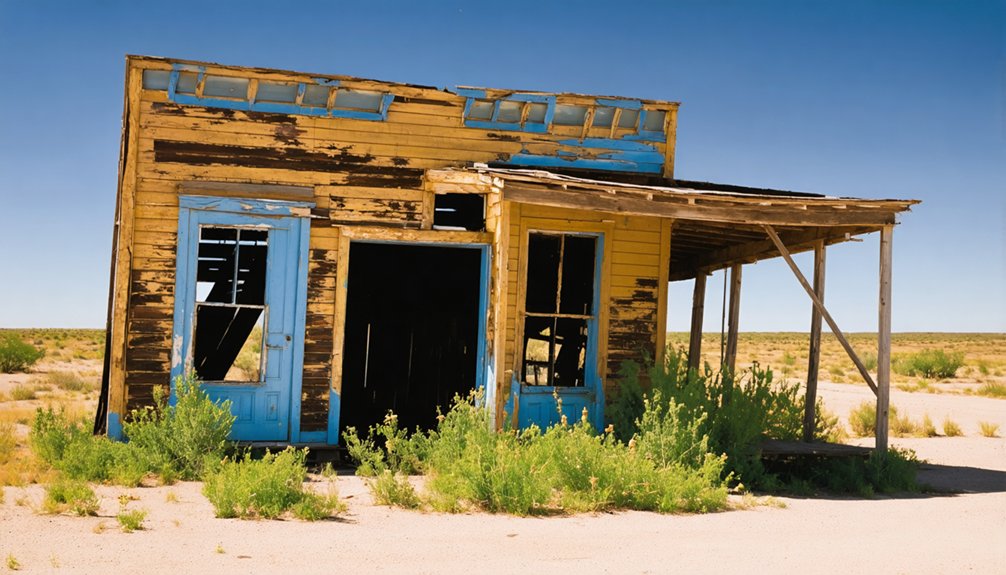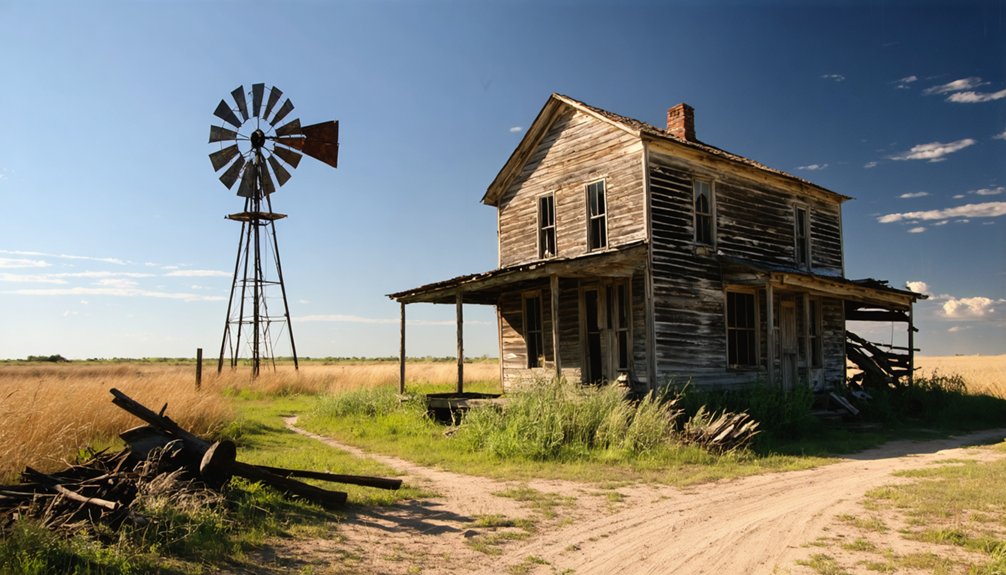You’ll find Spurlin, Texas, a former ranching community established in 1908 through John L. Spurlin’s strategic land auction along the Stephenville North & South Texas Railway. The town’s brief significance centered on ranching operations, with a brick schoolhouse and church serving as community anchors by 1936. Today, only crumbling brick walls remain of this Hamilton County ghost town, which declined after being bypassed by railroad expansion. The story of Spurlin’s rise and fall reveals fascinating insights into early 20th-century Texas development.
Key Takeaways
- Spurlin was established in 1908 through a land auction organized by John L. Spurlin along the Stephenville North & South Texas Railway.
- The town initially thrived as a ranching community with a brick schoolhouse, church, and depot serving as community centers.
- By 1936, Spurlin had declined to just one church and business, relying on nearby Carlton for essential services.
- Economic dependence on ranching and the decline of railroad transportation contributed to the town’s eventual abandonment.
- Today, only crumbling brick walls of the schoolhouse remain, with the site largely existing on private property.
Origins and Early Settlement
While many Texas ghost towns emerged from mining or industrial ventures, Spurlin began as a deliberately planned ranching community in Hamilton County, roughly four miles from Carlton.
In early 1900s Texas, John L. Spurlin orchestrated the town’s establishment, culminating in a November 1908 lot auction that defined initial settlement patterns. Much like how D. A. Spurlin had established roots in Virginia before moving west, the location’s strategic position along the Stephenville North & South Texas Railway made it attractive for agricultural practices and commerce. Like many of the 511 ghost towns across Texas, Spurlin’s story would eventually become part of the state’s rich historical tapestry.
You’ll find that Spurlin’s early development centered on ranching activities, with farming playing a supporting role in the local economy.
The 1908 Land Auction Era
The 1908 land auction marked a defining moment in Spurlin’s establishment, drawing settlers and investors to this promising Hamilton County locale. The auction strategies employed during this period reflected Texas’s broader efforts to promote competitive bidding and maximize land valuations through organized sales events. Similar to how sworn statements of loss were required in later property transactions, these early land auctions maintained strict documentation requirements. To minimize errors and confusion, officials utilized disambiguation resources to properly identify and record county locations during the auction process.
You’ll find that these auctions served as vital mechanisms for transferring both government-granted and private lands into settlers’ hands. County and state statutes governed the proceedings, ensuring legal clarity in ownership transfers.
If you’d examined the county clerk records from this era, you’d have discovered detailed documentation of sale prices, survey records, and title transfers – all essential elements that shaped Spurlin’s early development and subsequent shift from cropland to livestock-focused agriculture, setting the stage for the community’s future economic trajectory.
Community Life and Infrastructure
You’ll find that community life in Spurlin centered around its brick schoolhouse and church, which served as primary gathering places for social events and religious services by 1936.
The town’s infrastructure remained minimal, lacking modern utilities and relying on nearby Carlton for essential mail service. Unlike other mining towns of the era that had barbed wire fencing to control worker movement, Spurlin maintained an open layout. The community began with an impressive start when special trains brought auction attendees from neighboring cities.
While the church maintained its role as a key institution, the absence of commercial stores and industrial facilities distinguished Spurlin from more developed frontier communities.
Daily Social Gatherings
Life in Spurlin revolved around informal gathering spaces rather than established civic centers, with daily social interactions occurring primarily through local businesses and work-related meetings.
You’d find neighborly gatherings taking place at the local business that served as the community’s informal hub in 1936, while the Spurlin Depot acted as a vital meeting point for residents and visitors alike during auction events.
Similar to how Woodmen of the World established local chapters for community bonding, the ranching lifestyle naturally brought people together through shared work and barn meetings, compensating for the lack of formal social venues like restaurants or saloons.
While the railroad initially facilitated social connections with nearby towns like Stephenville and Hamilton, the rise of automobiles gradually altered these patterns.
You’ll notice how the community adapted to maintain social bonds despite limited infrastructure and the rural isolation created by 2WD-only road access.
Church and School Activities
While Spurlin’s brick schoolhouse and church stood as pillars of community life through the 1930s, these institutions served multiple functions beyond their primary religious and educational roles.
You’d find the school’s sliding interior doors opening to create spacious halls for community gatherings, while its built-in stage hosted student performances and town meetings. Much like the parent-built schools across Texas, these buildings represented the community’s dedication to education.
The church events calendar marked the spiritual and social rhythm of local life, offering regular services alongside seasonal celebrations.
You’d see the practical efficiency of these buildings through their dual-purpose design, as school rooms often transformed into spaces for religious education and community discussions.
The buildings’ versatile architecture supported everything from classroom instruction to holiday festivities, reflecting the close-knit nature of Spurlin’s ranching community until its eventual abandonment in the 1980s.
Essential Town Services
Despite its modest size, Spurlin’s essential services reflected the basic needs of a sparsely populated ranching community. You’d have found minimal civic infrastructure, with the town relying heavily on nearby Carlton for mail delivery and other basic services.
The brick schoolhouse, now reduced to crumbling walls, represented one of the few public investments in the settlement’s history. Community governance appeared informal, with no documented town hall or municipal structure to oversee local affairs.
You wouldn’t have found dedicated utilities, healthcare facilities, or emergency services in Spurlin. Instead, the railroad initially served as the town’s lifeline, connecting residents to wider resources until automotive transportation changed regional patterns.
Economic Activities and Ranching Heritage

You’ll find that Spurlin’s economic foundation rested firmly on ranching operations, which thrived due to the region’s fertile grazing lands and the town’s strategic location along the railroad.
The town’s initial growth was propelled by John L. Spurlin’s ambitious land sale ventures, including the notable 1908 auction that attracted buyers via special trains from neighboring cities. Much like modern ranch real estate specialists, Spurlin understood the value of strategic land management and sales.
As automobile transportation gained prominence and railroad dependency waned in the early to mid-20th century, Spurlin’s economy deteriorated, following a pattern common to many rural Texas communities of that era. Like many other communities, the town’s decline left behind abandoned structures that serve as silent testaments to its once-thriving past.
Early Ranching Operations
As one of countless ranching communities that emerged in northwestern Hamilton County, Spurlin established itself through livestock production and agricultural activities that sustained its early residents.
You’ll find that early ranching techniques centered around cattle operations, which formed the backbone of the local economy and influenced the development of essential infrastructure.
While specific livestock breeds aren’t documented, ranching operations supported the growth of community institutions, including a church and local business by 1936.
You’ll notice how the town functioned as a significant hub for surrounding ranchlands, with nearby Carlton providing critical mail services.
A significant land auction in 1908 likely expanded ranching operations, though the community’s self-reliant culture remained closely tied to traditional agricultural practices until its eventual decline in the late 1980s.
Land Sale Ventures
Land sale ventures in Spurlin underwent significant alteration when British financiers entered the market in 1884, establishing the Espuela Land and Cattle Company. You’ll find that this marked a pivotal shift in land ownership patterns, as the British enterprise purchased the Spur Ranch in 1885.
Economic shifts became evident when drought and unstable cattle markets forced the British investors to sell their holdings for five dollars per acre in the early 1900s.
The Spur Syndicate, led by E.P. and S.A. Swenson, acquired the property in 1906, implementing a partnership model that brought fresh capital and management strategies. Under Charles A. Jones’s leadership, the syndicate introduced organizational changes that sought to maximize operational efficiency.
These transactions included not just land, but also livestock, equipment, and infrastructure improvements, reflecting the all-encompassing nature of ranch enterprise sales during this period.
Regional Economic Decline
The economic decline of Spurlin became evident through its heavy dependence on ranching activities and limited infrastructure.
You’ll find that by 1936, the town’s economic vulnerability was already apparent, with just a single church and business serving the community. The lack of economic diversification beyond ranching left Spurlin exposed to market fluctuations and agricultural challenges like drought.
As transportation evolved and the railroad was abandoned, you’d notice a sharp population decline that ultimately led to Spurlin’s disappearance from maps by the late 1980s.
The workforce’s specialization in ranching made it difficult to adapt when the industry faced downturns. Essential services vanished, and without significant industrial alternatives or proper market access, the town couldn’t sustain its economic viability.
The Path to Abandonment

When railroad expansion bypassed Spurlin in the early 1900s, this Hamilton County ranching community began its slow descent into abandonment.
Despite early optimism during the 1908 lot auctions, transportation shifts gradually eroded Spurlin’s economic foundation.
You’d have seen the impact of automobiles enabling residents to shop in larger towns, while demographic trends showed younger generations seeking opportunities elsewhere.
Legacy and Present-Day Remnants
Modern visitors to Spurlin’s former location will find little evidence of the once-hopeful ranching community, save for the crumbling brick walls of its abandoned schoolhouse.
The site’s historical significance lies in its reflection of early 20th-century rural Texas development and transportation evolution.
If you’re planning to explore this ghost town, be aware of these key aspects:
- Access is potentially restricted due to private property status
- No active infrastructure remains – all commercial buildings and churches have vanished
- The original depot location, central to the 1908 town lot auctions, is no longer visible
Today, Spurlin exists primarily in historical archives and ghost town registries, serving as a reflection of how changing transportation patterns and economic shifts can lead to the complete dissolution of rural communities.
Frequently Asked Questions
Were Any Notable Historical Figures or Outlaws Associated With Spurlin?
You won’t find any outlaw legends or historically significant figures tied to Spurlin’s past. Historical records don’t mention any notable personalities associated with this small ranching community.
What Natural Disasters or Events Contributed to Spurlin’s Decline?
While drought effects likely impacted local ranching operations, there’s no definitive record of major natural disasters in Spurlin. You won’t find evidence of significant flood damage affecting the town’s decline.
Did Spurlin Have a School During Its Active Years?
Like a vintage laptop in an old classroom, you’d find a brick schoolhouse in Spurlin during its active years. Historical evidence shows education was important to the Spurlin community through physical ruins.
What Happened to the Original Property Deeds From Spurlin?
You’ll find that Spurlin’s property history is largely unclear – many original deed transfers were likely lost, scattered among private collections, or destroyed through courthouse fires and general deterioration over time.
Were There Any Native American Settlements in the Spurlin Area?
Like footprints in time, you’ll find evidence of Native tribes near Spurlin, particularly the Caddo, who established settlements in East Texas, while Waco, Tawakoni, and Anadarko peoples used nearby hunting grounds.
References
- https://texashighways.com/travel-news/four-texas-ghost-towns/
- https://en.wikipedia.org/wiki/Spurlin
- https://www.youtube.com/watch?v=phjUE19A8HM
- https://en.wikipedia.org/wiki/List_of_ghost_towns_in_Texas
- https://texashistory.unt.edu/ark:/67531/metapth61101/
- https://texashistory.unt.edu/ark:/67531/metapth61101/m1/133/
- https://www.ghosttowns.com/states/tx/spurlin.html
- https://discovertexasoutdoors.com/places/spurlin/
- https://www.texasstandard.org/ghost-towns/
- https://law.justia.com/cases/federal/district-courts/FSupp/501/942/2378799/



